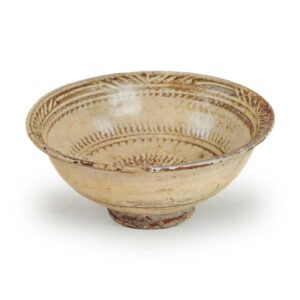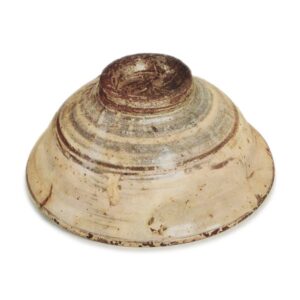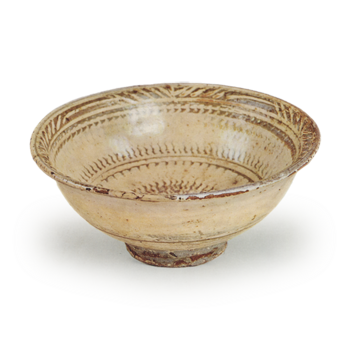

Held in the Hatakeyama Memorial Museum
Height: 5.8-6.0cm
Diameter: 13.2-13.3cm
Outer diameter of foot ring: 4.6cm
Height of rim: 1.0-1.2cm
This is a small tea bowl with a bright feel, with a well-formed shape and color, and it belongs to the Kosanzan category of Riketsu ware. It is probably best viewed as a type of Ueda Riketsu ware.
The clay body is rich in iron and other impurities, and it is fired to a dark gray color, creating a striking contrast with the white of the thickly applied slip. The potter’s wheel-formed body is well-proportioned, and the rim is gently turned outwards, beautifully connecting with the round foot of the body. In addition, the foot ring is made from a thin piece of bamboo, and the carving is sharp and deep. There is a small line-carved pattern on the bottom, which looks like a kiln mark, but this was probably made by the tip of the carving hook by accident.
The pattern is applied to the inside of the bowl, and the outside is only covered in white slip. First, on the inside of the rim, a simple grass pattern is carved in four places within a thin band, and fine zigzag vertical lines are carved in a radial pattern in the center of the two sections of the body and the bottom. This part is made using a technique called odori-kagi or tobikaki, which makes use of the momentum of the potter’s wheel, and the name Mishima Rekite comes from the fact that the pattern is similar to the calendar used at the Mishima Shrine. In this tea bowl, the staggered, continuous pattern is particularly effective. After carving the pattern, the surface is covered with a generous amount of white slip, and then wiped off. The carved lines are filled with white clay, and the excess clay is left exposed, creating an inlaid pattern.
The outside is thickly coated with white slip from the rim to the foot of the bowl, and the carved pattern is not added to the clay body. The strong scraping of a single line at the waist reveals the dark clay body, which helps to tighten up the overall appearance. The part from the line to the foot of the bowl has been roughly wiped with a cloth or something, so the white slip is left in a light, faded pattern. The potter’s hands must have worked unconsciously, but the result is a pleasing harmony. The glaze that has been applied to the entire surface is clear and transparent, and it blends beautifully with the clay and white slip. The luster and moisture are the unique characteristics of this type of Mishima ware.
There are five sand-filled areas in the interior. There is a little glaze flaking off the rim, and the makeup is flaking off in spots, looking like insect damage. Apart from a short vertical groove, there are no other flaws. By the way, what does the name “Tei” on this tea bowl mean? According to the dictionary, the character “tei” means “to stay, to watch, to stay, to stay”, as well as “to be flat, to be settled, to be prepared, to be correct, to be divided, to be nurtured, to be excellent”. , “arrive at, correct, divide, nurture, excel”, etc., but which of these meanings does it have? Or does it have a completely different meaning, and it is difficult to judge. The name of the tei is based on the inscription on the inner box, which reads “Mishima Tei Usucha Teacup”. It is said that this is a note written by Lord Maeda Toshitsune (Komatsu Nakanojo, who died in 1658 at the age of 66), and the name “Tei” may have been written by Lord Toshitsune. This tea bowl is already introduced in the “Taisho Meiki Kan” (A Guide to Famous Tea Bowls of the Taisho Period), but the name “Tei” is not explained. The name of the tea bowl is simply referred to as “Kosanjima”, and the name “Tei” is not mentioned. It is likely that this was also a mystery to Takahashi Chubian, the compiler of the book.
It was in the possession of the Maeda family of Kaga since the time of Maeda Toshitsune, but in 1925 it was sold at auction by the Maeda family and entered the Sekido family of Nagoya, and later became the property of Hata-kawa Kazukiyo, and is now in the collection of the Hata-kawa Memorial Museum.



